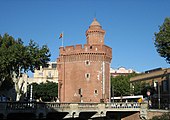Perpignan: French commune in Pyrénées-Orientales, Occitania
Perpignan (Catalan: Perpinyà) is a city in the south of France.
It is also a commune and the capital of the Pyrénées-Orientales department. Perpignan was the capital of the old province and county of Roussillon (Rosselló in Catalan) and continental capital of the Kingdom of Majorca in the 13th and 14th centuries.
Perpignan Perpinyà | |
|---|---|
Prefecture and commune | |
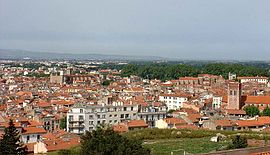 Aerial view of Perpignan | |
| Coordinates: 42°41′55″N 2°53′44″E / 42.6986°N 2.8956°E | |
| Country | France |
| Region | Occitanie |
| Department | Pyrénées-Orientales |
| Arrondissement | Perpignan |
| Canton | Perpignan-1, Perpignan-2, Perpignan-3, Perpignan-4, Perpignan-5, Perpignan-6 |
| Intercommunality | Perpignan Méditerranée |
| Government | |
| • Mayor (2020-) | Louis Aliot (RN) |
| Area 1 | 68.07 km2 (26.28 sq mi) |
| Population (2014) | 120,605 |
| • Density | 1,800/km2 (4,600/sq mi) |
| Demonym | Perpignanais |
| Time zone | UTC+01:00 (CET) |
| • Summer (DST) | UTC+02:00 (CEST) |
| INSEE/Postal code | 66136 /66000 |
| Elevation | 8–95 m (26–312 ft) (avg. 52 m or 171 ft) |
| Website | www.mairie-perpignan.fr |
| 1 French Land Register data, which excludes lakes, ponds, glaciers > 1 km2 (0.386 sq mi or 247 acres) and river estuaries. | |
Perpignan was named, from 2001, as a City of Art and History (French: Ville d'Art et d'Histoire) by the French Ministry of Culture and Communication.
Name of the city
Perpignan is mentioned in a document from 927 as Villa Perpinianum. Later, there are other, but similar, names:
- Villa Perpiniano (959)
- Pirpinianum (11th century)
- Perpiniani (1176)
- Perpenyà (13th century); this form was the most common until the 15th century and was used even during the 17th century.
In Catalan, the regional language of the Pyrénées-Orientales, the name of the city is Perpinyà.
History

Middle Ages
The medieval town of Perpignan seems to have been founded around the beginning of the 10th century (first mentioned in a document as villa Perpinianum in 927). Soon Perpignan became the capital of the County of Roussillon. The last Count of Rossillon, Girard II, gave his lands in 1172 to the King of Aragón and Count of Barcelona.
Perpignan was made a partly self-governing commune in 1197. The French king Louis IX gave the Roussillon to the Kingdom of Aragón by the Treaty of Corbeil (1258).

Kingdom of Majorca
When James I the Conqueror, king of Aragon and count of Barcelona, founded in 1229 the Kingdom of Majorca, Perpignan became the capital of the territory on the mainland. This continued from 1278 to 1344. The Castle of the Kings of Majorca (French: Palais des rois de Majorque) was built during this period. The different parts of the kingdom were the Balearic Islands, Northern Catalonia (Roussillon and Cerdagne) and the coastal area of Montpellier.
This period is considered the golden age in the history of the city. Perpignan became an important center of cloth industry, leather and goldsmiths' and other crafts.
Principality of Catalonia
In 1344 Peter IV of Aragon took the Kingdom of Majorca and Perpignan once more became part of the County of Barcelona. A few years later Perpignan lost approximately half of its population to the Black Death. Perpignan was attacked and occupied by Louis XI of France in 1463, but in 1493 Charles VIII of France gave it back to Ferdinand II of Aragon.
Again Perpignan was taken by the French during the Thirty Years' War in September 1642. Perpignan was finally given by Spain to France, and from then on it is part of France.

Coat of arms
The coat of arms of Perpignan shows, as is the case in other cities in the region, the patron saint of the city. Here St John the Baptist is represented in front of the Catalan colours (yellow and red) with a lamb and a Christian cross in his hands, and walking above water.
Geography
Perpignan is at the centre of Roussillon, an old province organized around an agricultural plain. The city is at approximately 15 km (9 mi) from the Mediterranean Sea and about 60 km (37 mi) from the Pyrenees mountain range.
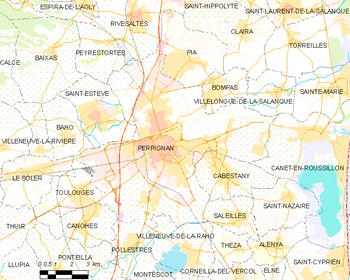 |
It has an area of 68.07 km2 (26.28 sq mi) and its average altitude is 52 m (171 ft); at the city hall, the altitude is 40 m (130 ft).
Perpignan is in the valley of the Têt river, in the Roussillon plain which is bordered to the south by the Pyrenees, to the west by the region of Corbières and to the east by the Mediterranean Sea. The old city is on the right side of the Têt river, where the small river La Basse joins the Têt.
It is the southernmost of the great cities of metropolitan France (French: France métropolitaine).
The cities of Pia and Cabestany are now part of Perpignan, while Bompas, Saleilles, Canohès, Toulouges, Le Soler, Baho, Saint-Estève and Rivesaltes are all close to the city limits. Nearest cities are Narbonne to the north (65 km), Montpellier towards the northeast (150 km), Barcelona to the south (190 km) and Toulouse to the northwest (200 km). The distance to Paris is 850 km (528 mi).

Climate
The climate of Perpignan is a warm Mediterranean climate (Köppen climate classification Cfa), with mild winters and dry summers and warm.
The average temperature for the year in Perpignan is 15.6 °C (60.0 °F). The warmest month, on average, is July with an average temperature of 23.9 °C (75.0 °F). The coolest month on average is January, with an average temperature of 8.3 °C (47.0 °F).
The average amount of precipitation for the year in Perpignan is 584.0 mm (23.0 in). The month with the most precipitation on average is October with 78.7 mm (3.1 in) of precipitation. The month with the least precipitation on average is July with an average of 20.3 mm (0.8 in).
| Climate data for Perpignan, Pyrénées-Orientales, France | |||||||||||||
|---|---|---|---|---|---|---|---|---|---|---|---|---|---|
| Month | Jan | Feb | Mar | Apr | May | Jun | Jul | Aug | Sep | Oct | Nov | Dec | Year |
| Daily mean °C (°F) | 8 (46) | 8 (46) | 11 (52) | 13 (55) | 16 (61) | 20 (68) | 23 (73) | 23 (73) | 20 (68) | 16 (61) | 11 (52) | 9 (48) | 15 (59) |
| Average rainfall mm (inches) | 50 (2.0) | 40 (1.6) | 50 (2.0) | 40 (1.6) | 50 (2.0) | 30 (1.2) | 20 (0.8) | 20 (0.8) | 50 (2.0) | 70 (2.8) | 50 (2.0) | 50 (2.0) | 520 (20.8) |
| Source: Weatherbase.com [1] | |||||||||||||
Population
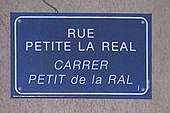
The men of Perpignan are called perpignanais (women, perpignanaises); in Catalan, perpinyanès for a man and perpinyanesa for a woman.
In Perpignan, both French and Catalan are spoken, as can be seen in the street signs.
With a population in 2014 of 120,605, Perpignan has a population density of 1,772 inhabitants/km2.
Evolution of the population in Perpignan
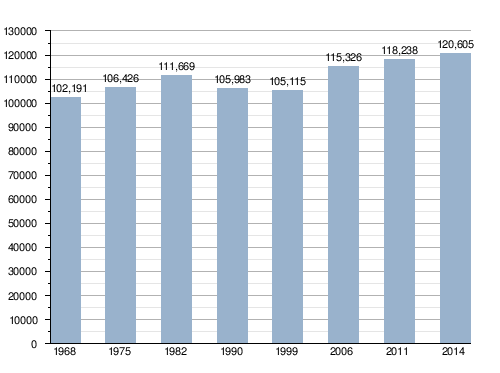
Perpignan forms with 66 communes the urban area of Perpignan with a population of 313,861 inhabitants (2013) and an area of 981.7 km2 (379.0 sq mi). The centre of this urban area is the metropolitan area of Perpignan, formed by 15 communes with a population of 197,715 inhabitants and an area of 217.5 km2 (84.0 sq mi).
Administration
Perpignan is the prefecture of the Pyrénées-Orientales department since 1790. It is also the capital of the arrondissement of Perpignan and the administrative centre (French: chef-lieu) of six cantons:
- Perpignan-1 : part of Perpignan, with 28,922 inhabitants (2014)
- Perpignan-2 : 3 communes (Bompas, Sainte-Marie, Villelongue-de-la-Salanque) + part of Perpignan, with 29,798 inhabitants (2014)
- Perpignan-3 : 1 commune (Cabestany) + part of Perpignan, with 25,633 inhabitants (2014)
- Perpignan-4 : part of Perpignan, with 23,862 inhabitants (2014)
- Perpignan-5 : 1 commune (Canohès) + part of Perpignan, with 25,119 inhabitants (2014)
- Perpignan-6 : 1 commune (Toulouges) + part of Perpignan, with 23,969 inhabitants (2014)
It is part of the intercommunality Perpignan Méditerranée (French: Intercommunalité-Métropole de CU Perpignan Méditerranée (Pmcu)).
Twinned and partner towns
Perpignan is twinned with:
Economy
Traditional commerce is in wine and olive oil, corks (the cork oak Quercus suber grows in Perpignan's mild climate), wool and leather, and iron.
Gallery
- Le Castillet
- Bridge over river Basse
- Mermaids fountain
- Town Centre
- Château Roussillon : tower of the old castle (13th and 14th centuries)
- Château Roussillon : Sainte-Marie and Saint-Pierre chapel (11th and 12th centuries)
- Cathédrale Saint-Jean
- Perpignan Cathedral
Notes
Related pages
References
Other websites

- City council website[permanent dead link] (in French and Catalan)
- History of Perpignan (in French)
- Perpignan Tourist Office (in French, English, German, Spanish, and Catalan)
- Museum guide
- Unofficial guide to Perpignan Airport Archived 2013-06-23 at the Wayback Machine
- Companie Transports – Public Bus System (in French)
This article uses material from the Wikipedia Simple English article Perpignan, which is released under the Creative Commons Attribution-ShareAlike 3.0 license ("CC BY-SA 3.0"); additional terms may apply (view authors). Content is available under CC BY-SA 4.0 unless otherwise noted. Images, videos and audio are available under their respective licenses.
®Wikipedia is a registered trademark of the Wiki Foundation, Inc. Wiki Simple English (DUHOCTRUNGQUOC.VN) is an independent company and has no affiliation with Wiki Foundation.










